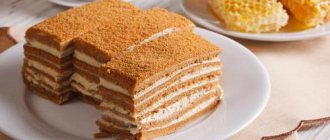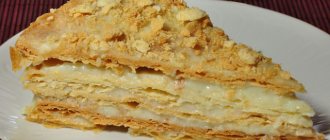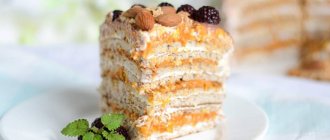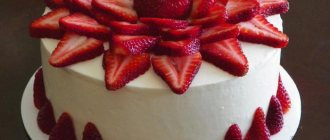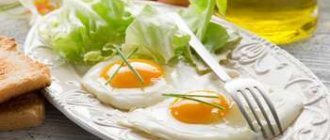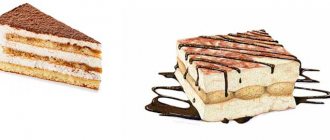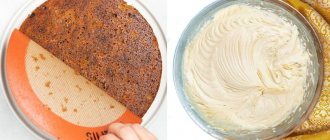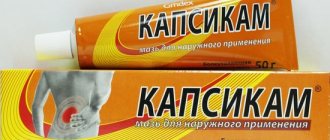Classic Napoleon cake
The famous sweet dessert always pleases with its delicate taste, delicate aroma of fresh cakes and soft texture. It’s pleasant to enjoy it, but some people already after a few days regret eating the cake, because their weight suffered from it - as a rule, it increased.
This is not surprising, because the dessert contains white wheat flour, margarine, sugar, milk and eggs. Taken together, all this represents a kind of carbohydrate-fat bomb, which can constitute a fair share of a person’s daily requirement for these substances.
Calorie content of “Napoleon” per 100 grams of dessert
The classic recipe for a ready-made custard cake has approximately the following set of ingredients:
- puff pastry (ready-made or homemade);
- eggs;
- nuts;
- flour;
- milk;
- sugar;
- vanilla sugar.
There are many variations on the theme of preparing cream: from whipped cream to butter composition, so the calorie content of Napoleon cake largely depends on the components of the cream.
In the classic recipe, the calculation of proteins, fats and carbohydrates is presented in the following quantities:
The calorie content of “Napoleon” in this case is 315.8. When changing the cream, the calorie content may increase to 500 kcal per 0.1 kg of cake. Therefore, when they talk about the calorie content of “Napoleon” (per 100 grams), they mean the average value (approximately 400 kcal).
How many calories are in Napoleon Cake with Custard?
Here's how much:
We prepare this dish with the following recipe:
Products (for 6 servings):
- Puff pastry - 1300 g - (4706 kcal)
- Milk - 1.5 l. — (780 kcal)
- Eggs - 3 pcs. — (235 kcal)
- Sugar - 200 g - (748 kcal)
- Starch - 4 teaspoons - (60 kcal)
- Vanilla sugar - 8 g - (5 kcal)
- Butter - 100 g - (748 kcal)
How to cook:
- Place milk (1.25 l) on low heat.
- Separate the yolks from the whites, combine with sugar and stir with a whisk.
- Mix the remaining milk with starch.
- Stirring constantly, gradually add the yolks to the pan with milk.
- Without stopping stirring, pour in the milk and starch, remove the cream from the heat and cool to 40 degrees.
- Sprinkle the puff pastry with flour, roll it out into a layer 2-3 mm thick, cut it into 3 parts, place it on a baking sheet covered with parchment and bake the cake layers at 190 degrees for 2.5-3 minutes.
- Coat the cakes well with orange cream and put them in the refrigerator for several hours to soak.
Based on the posted recipe:
Calorie content of Napoleon cake with custard, per 100 grams, is:
Napoleon for those who are on a diet
What should those who love sweets, but want to change their weight or improve the quality of their figure, do? The answer that will solve this problem 100% is to stop eating sweets. But not everyone is ready for this. Therefore, there are a couple of ways to reduce the “danger” of the high calorie content of “Napoleon”:
- First, calculate your individual KBJU norm for the day and eat a small piece of cake without exceeding the established norm (you need to understand that this will entail a decrease in the remaining amounts of food).
- Secondly, try to reduce the calorie content of Napoleon as much as possible by changing the quantity and quality of some ingredients.
If everything is clear with the first point, then what can you suggest for the second point? To begin with, we minimize the calories in the recipe, that is, instead of buttercream, choose custard. Then you can reduce the amount of sugar - instead of the full amount in the recipe, use half. This will not greatly affect the taste of the finished dessert. In extreme cases, sugar is completely replaced with a sweetener.
Alternatively, you can experiment with milk: take cow's milk with a lower percentage of fat content or completely replace it with a mixture of coconut and soy.
If you use homemade dough to make a cake, then it would be ideal to replace wheat flour with bran, whole grain or oat flour.
In general, it is clear that even while on a diet, you can treat yourself to sweets. The main thing is to correctly calculate the calorie content of the Napoleon cake and treat yourself to dessert no more than 2 times a week.
During a diet, those who want to lose weight have to greatly limit themselves. Low-fat yogurts, vegetables, dietary meats and fruits are usually considered the most suitable foods for those struggling with extra pounds. But usually you want to eat something completely different: sweets, flour and fatty foods. The question arises, what is the calorie content of the cake? Is it really impossible for those who are on a diet to afford at least a piece?
How many calories are in a cake?
Cake is a delicious type of dessert. The cake consists of several cake layers soaked in cream. This sweetness is decorated with glaze, cream, and fruit on top. How many calories are in the cake depends on the type of cream, dough, and decoration method. The calorie content of the cream can be 150 kilocalories or 300, and much more. The nutritional value of custard is 211 kilocalories per 100 grams. The calorie content of protein cream is 270 kilocalories. The calorie content of butter cream with condensed milk is 350 kilocalories. Recipes for low-calorie creams are not used so often. To reduce calories in your cake, make cream from banana and cottage cheese or yogurt. To reduce the calorie content of the cake, decorate the confectionery with fruit. It is tasty, healthy, and does not harm your figure. The dough for a biscuit product has an energy value of about 300 kilocalories. Cakes are rich in carbohydrates and fats. Try not to use too much sponge for your cake. There will be fewer calories in the cake if you layer fruit between the layers.
Recipe Napoleon with custard. Calorie, chemical composition and nutritional value.
Nutritional value and chemical composition of “Napoleon with custard.”
The table shows the nutritional content (calories, proteins, fats, carbohydrates, vitamins and minerals) per 100 grams of edible portion.
| Nutrient | Quantity | Norm** | % of the norm in 100 g | % of the norm in 100 kcal | 100% normal |
| Calorie content | 215 kcal | 1684 kcal | 12.8% | 6% | 783 g |
| Squirrels | 5 g | 76 g | 6.6% | 3.1% | 1520 g |
| Fats | 9.9 g | 56 g | 17.7% | 8.2% | 566 g |
| Carbohydrates | 26.3 g | 219 g | 12% | 5.6% | 833 g |
| Alimentary fiber | 0.7 g | 20 g | 3.5% | 1.6% | 2857 g |
| Water | 57.4 g | 2273 g | 2.5% | 1.2% | 3960 g |
| Ash | 0.558 g | ~ | |||
| Vitamins | |||||
| Vitamin A, RE | 90.8 mcg | 900 mcg | 10.1% | 4.7% | 991 g |
| Retinol | 0.084 mg | ~ | |||
| beta carotene | 0.04 mg | 5 mg | 0.8% | 0.4% | 12500 g |
| Vitamin B1, thiamine | 0.053 mg | 1.5 mg | 3.5% | 1.6% | 2830 g |
| Vitamin B2, riboflavin | 0.123 mg | 1.8 mg | 6.8% | 3.2% | 1463 g |
| Vitamin B4, choline | 47.36 mg | 500 mg | 9.5% | 4.4% | 1056 g |
| Vitamin B5, pantothenic | 0.3 mg | 5 mg | 6% | 2.8% | 1667 g |
| Vitamin B6, pyridoxine | 0.063 mg | 2 mg | 3.2% | 1.5% | 3175 g |
| Vitamin B9, folates | 7.84 mcg | 400 mcg | 2% | 0.9% | 5102 g |
| Vitamin B12, cobalamin | 0.146 mcg | 3 mcg | 4.9% | 2.3% | 2055 g |
| Vitamin C, ascorbic acid | 0.26 mg | 90 mg | 0.3% | 0.1% | 34615 g |
| Vitamin D, calciferol | 0.389 mcg | 10 mcg | 3.9% | 1.8% | 2571 g |
| Vitamin E, alpha tocopherol, TE | 0.472 mg | 15 mg | 3.1% | 1.4% | 3178 g |
| Vitamin H, biotin | 4.066 mcg | 50 mcg | 8.1% | 3.8% | 1230 g |
| Vitamin K, phylloquinone | 0.8 mcg | 120 mcg | 0.7% | 0.3% | 15000 g |
| Vitamin RR, NE | 1.404 mg | 20 mg | 7% | 3.3% | 1425 g |
| Niacin | 0.319 mg | ~ | |||
| Macronutrients | |||||
| Potassium, K | 107.42 mg | 2500 mg | 4.3% | 2% | 2327 g |
| Calcium, Ca | 64.37 mg | 1000 mg | 6.4% | 3% | 1554 g |
| Silicon, Si | 0.848 mg | 30 mg | 2.8% | 1.3% | 3538 g |
| Magnesium, Mg | 10.95 mg | 400 mg | 2.7% | 1.3% | 3653 g |
| Sodium, Na | 38.38 mg | 1300 mg | 3% | 1.4% | 3387 g |
| Sera, S | 47.51 mg | 1000 mg | 4.8% | 2.2% | 2105 g |
| Phosphorus, P | 80.8 mg | 800 mg | 10.1% | 4.7% | 990 g |
| Chlorine, Cl | 65.61 mg | 2300 mg | 2.9% | 1.3% | 3506 g |
| Microelements | |||||
| Aluminium, Al | 244.6 mcg | ~ | |||
| Bor, B | 7.8 mcg | ~ | |||
| Vanadium, V | 19.07 mcg | ~ | |||
| Iron, Fe | 0.62 mg | 18 mg | 3.4% | 1.6% | 2903 g |
| Yod, I | 6.5 mcg | 150 mcg | 4.3% | 2% | 2308 g |
| Cobalt, Co | 1.84 mcg | 10 mcg | 18.4% | 8.6% | 543 g |
| Manganese, Mn | 0.1264 mg | 2 mg | 6.3% | 2.9% | 1582 g |
| Copper, Cu | 36.37 mcg | 1000 mcg | 3.6% | 1.7% | 2750 g |
| Molybdenum, Mo | 5.519 mcg | 70 mcg | 7.9% | 3.7% | 1268 g |
| Nickel, Ni | 0.466 mcg | ~ | |||
| Tin, Sn | 7.72 mcg | ~ | |||
| Selenium, Se | 5.19 mcg | 55 mcg | 9.4% | 4.4% | 1060 g |
| Strontium, Sr | 7.51 mcg | ~ | |||
| Titanium, Ti | 2.33 mcg | ~ | |||
| Fluorine, F | 24.29 mcg | 4000 mcg | 0.6% | 0.3% | 16468 g |
| Chromium, Cr | 1.79 mcg | 50 mcg | 3.6% | 1.7% | 2793 g |
| Zinc, Zn | 0.4563 mg | 12 mg | 3.8% | 1.8% | 2630 g |
| Digestible carbohydrates | |||||
| Starch and dextrins | 14.389 g | ~ | |||
| Mono- and disaccharides (sugars) | 11.7 g | max 100 g | |||
| Essential amino acids | |||||
| Arginine* | 0.089 g | ~ | |||
| Valin | 0.088 g | ~ | |||
| Histidine* | 0.039 g | ~ | |||
| Isoleucine | 0.069 g | ~ | |||
| Leucine | 0.124 g | ~ | |||
| Lysine | 0.102 g | ~ | |||
| Methionine | 0.047 g | ~ | |||
| Methionine + Cysteine | 0.081 g | ~ | |||
| Threonine | 0.07 g | ~ | |||
| Tryptophan | 0.025 g | ~ | |||
| Phenylalanine | 0.074 g | ~ | |||
| Phenylalanine+Tyrosine | 0.129 g | ~ | |||
| Nonessential amino acids | |||||
| Alanin | 0.08 g | ~ | |||
| Aspartic acid | 0.139 g | ~ | |||
| Glycine | 0.048 g | ~ | |||
| Glutamic acid | 0.203 g | ~ | |||
| Proline | 0.047 g | ~ | |||
| Serin | 0.105 g | ~ | |||
| Tyrosine | 0.056 g | ~ | |||
| Cysteine | 0.033 g | ~ | |||
| Sterols (sterols) | |||||
| Cholesterol | 82.78 mg | max 300 mg | |||
| Saturated fatty acids | |||||
| Saturated fatty acids | 5.8 g | max 18.7 g | |||
| 4:0 Oil | 0.33 g | ~ | |||
| 6:0 Kapronovaya | 0.073 g | ~ | |||
| 8:0 Caprylic | 0.064 g | ~ | |||
| 10:0 Kaprinovaya | 0.167 g | ~ | |||
| 12:0 Lauric | 0.214 g | ~ | |||
| 14:0 Miristinovaya | 0.696 g | ~ | |||
| 15:0 Pentadecane | 0.001 g | ~ | |||
| 16:0 Palmitinaya | 2.399 g | ~ | |||
| 17:0 Margarine | 0.003 g | ~ | |||
| 18:0 Stearic | 0.761 g | ~ | |||
| 20:0 Arakhinovaya | 0.003 g | ~ | |||
| Monounsaturated fatty acids | 3.254 g | min 16.8 g | 19.4% | 9% | |
| 14:1 Myristoleic | 0.074 g | ~ | |||
| 16:1 Palmitoleic | 0.296 g | ~ | |||
| 17:1 Heptadecene | 0.001 g | ~ | |||
| 18:1 Oleic (omega-9) | 2.458 g | ~ | |||
| 20:1 Gadoleic (omega-9) | 0.004 g | ~ | |||
| Polyunsaturated fatty acids | 0.388 g | from 11.2 to 20.6 g | 3.5% | 1.6% | |
| 18:2 Linolevaya | 0.196 g | ~ | |||
| 18:3 Linolenic | 0.013 g | ~ | |||
| 20:4 Arachidonic | 0.011 g | ~ | |||
| Omega-6 fatty acids | 0.4 g | from 4.7 to 16.8 g | 8.5% | 4% |
The energy value of Napoleon with custard is 215 kcal.
Primary Source: Created in the application by the user. Read more.
** This table shows the average levels of vitamins and minerals for an adult. If you want to know the norms taking into account your gender, age and other factors, then use the “My Healthy Diet” application.
Calorie content of “Napoleon” and other popular cakes
The calorie content of Bird's Milk is 410 kilocalories per 100 grams. The consumption of this delicious dessert should be limited to 1 piece per day. You should eat cake no more than 2-3 times a month. The calorie content of “Napoleon” is even greater. It is approximately equal to 440 kilocalories. “Honey cake” is very high in calories. Its nutritional value is 478 kilocalories per 100 grams. 100 grams of “Flight” meringue cake has a nutritional value of 450 kilocalories. The calorie content of the Mask cake is 350 kilocalories per 100 grams. Prague cake contains 480 kilocalories per 100 grams. “Truffle” is somewhat less rich in calories - only 345 per 100 grams. The famous “Sorceress” has a calorie content of 350 kilocalories. Now you can buy lower-calorie products. There are about 250 calories in the Yogurt cake. Other low-calorie products also do not contain cream. A whole series of confectionery products has an energy value of 145 kilocalories per 100 grams. These products include the Lenten Orange cake, the Lenten Berry cake, and the Lenten Beetroot cake. Low-calorie cakes contain minimal fat and sugar. Of course, they should not be abused. But you can treat yourself to such a dessert several times a week. The calorie content of cakes is high in any case, so one serving on a plate should be no more than 100 grams.
Recipe for Napoleon with condensed milk. Calorie, chemical composition and nutritional value.
Nutritional value and chemical composition of “Napoleon with condensed milk.”
The table shows the nutritional content (calories, proteins, fats, carbohydrates, vitamins and minerals) per 100 grams of edible portion.
| Nutrient | Quantity | Norm** | % of the norm in 100 g | % of the norm in 100 kcal | 100% normal |
| Calorie content | 310.6 kcal | 1684 kcal | 18.4% | 5.9% | 542 g |
| Squirrels | 4.9 g | 76 g | 6.4% | 2.1% | 1551 g |
| Fats | 15.3 g | 56 g | 27.3% | 8.8% | 366 g |
| Carbohydrates | 38.1 g | 219 g | 17.4% | 5.6% | 575 g |
| Organic acids | 0.1 g | ~ | |||
| Water | 21 g | 2273 g | 0.9% | 0.3% | 10824 g |
| Ash | 0.471 g | ~ | |||
| Vitamins | |||||
| Vitamin A, RE | 78.3 mcg | 900 mcg | 8.7% | 2.8% | 1149 g |
| Retinol | 0.076 mg | ~ | |||
| beta carotene | 0.021 mg | 5 mg | 0.4% | 0.1% | 23810 g |
| Vitamin B1, thiamine | 0.018 mg | 1.5 mg | 1.2% | 0.4% | 8333 g |
| Vitamin B2, riboflavin | 0.107 mg | 1.8 mg | 5.9% | 1.9% | 1682 g |
| Vitamin B4, choline | 10.09 mg | 500 mg | 2% | 0.6% | 4955 g |
| Vitamin B5, pantothenic | 0.222 mg | 5 mg | 4.4% | 1.4% | 2252 g |
| Vitamin B6, pyridoxine | 0.033 mg | 2 mg | 1.7% | 0.5% | 6061 g |
| Vitamin B9, folates | 1.385 mcg | 400 mcg | 0.3% | 0.1% | 28881 g |
| Vitamin B12, cobalamin | 0.148 mcg | 3 mcg | 4.9% | 1.6% | 2027 |
| Vitamin C, ascorbic acid | 0.35 mg | 90 mg | 0.4% | 0.1% | 25714 g |
| Vitamin D, calciferol | 0.158 mcg | 10 mcg | 1.6% | 0.5% | 6329 g |
| Vitamin D3, cholecalciferol | 0.148 mcg | ~ | |||
| Vitamin E, alpha tocopherol, TE | 0.257 mg | 15 mg | 1.7% | 0.5% | 5837 g |
| Vitamin H, biotin | 0.633 mcg | 50 mcg | 1.3% | 0.4% | 7899 g |
| Vitamin K, phylloquinone | 0.8 mcg | 120 mcg | 0.7% | 0.2% | 15000 g |
| Vitamin RR, NE | 0.3667 mg | 20 mg | 1.8% | 0.6% | 5454 g |
| Niacin | 0.04 mg | ~ | |||
| Macronutrients | |||||
| Potassium, K | 96.36 mg | 2500 mg | 3.9% | 1.3% | 2594 g |
| Calcium, Ca | 77.89 mg | 1000 mg | 7.8% | 2.5% | 1284 g |
| Magnesium, Mg | 8.46 mg | 400 mg | 2.1% | 0.7% | 4728 g |
| Sodium, Na | 34.26 mg | 1300 mg | 2.6% | 0.8% | 3795 g |
| Sera, S | 14.25 mg | 1000 mg | 1.4% | 0.5% | 7018 g |
| Phosphorus, P | 58.4 mg | 800 mg | 7.3% | 2.4% | 1370 g |
| Chlorine, Cl | 47.11 mg | 2300 mg | 2% | 0.6% | 4882 g |
| Microelements | |||||
| Iron, Fe | 0.051 mg | 18 mg | 0.3% | 0.1% | 35294 g |
| Yod, I | 1.39 mcg | 150 mcg | 0.9% | 0.3% | 10791 g |
| Cobalt, Co | 0.396 mcg | 10 mcg | 4% | 1.3% | 2525 g |
| Manganese, Mn | 0.0019 mg | 2 mg | 0.1% | 105263 g | |
| Copper, Cu | 8.09 mcg | 1000 mcg | 0.8% | 0.3% | 12361 g |
| Selenium, Se | 0.753 mcg | 55 mcg | 1.4% | 0.5% | 7304 g |
| Fluorine, F | 7.67 mcg | 4000 mcg | 0.2% | 0.1% | 52151 g |
| Zinc, Zn | 0.2604 mg | 12 mg | 2.2% | 0.7% | 4608 g |
| Digestible carbohydrates | |||||
| Starch and dextrins | 0.075 g | ~ | |||
| Mono- and disaccharides (sugars) | 17.5 g | max 100 g | |||
| Lactose | 2.474 g | ~ | |||
| Sucrose | 8.61 g | ~ | |||
| Essential amino acids | 0.561 g | ~ | |||
| Arginine* | 0.067 g | ~ | |||
| Valin | 0.126 g | ~ | |||
| Histidine* | 0.048 g | ~ | |||
| Isoleucine | 0.115 g | ~ | |||
| Leucine | 0.159 g | ~ | |||
| Lysine | 0.149 g | ~ | |||
| Methionine | 0.046 g | ~ | |||
| Methionine + Cysteine | 0.046 g | ~ | |||
| Threonine | 0.084 g | ~ | |||
| Tryptophan | 0.026 g | ~ | |||
| Phenylalanine | 0.089 g | ~ | |||
| Phenylalanine+Tyrosine | 0.131 g | ~ | |||
| Nonessential amino acids | 0.893 g | ~ | |||
| Alanin | 0.065 g | ~ | |||
| Aspartic acid | 0.146 g | ~ | |||
| Glycine | 0.039 g | ~ | |||
| Glutamic acid | 0.427 g | ~ | |||
| Proline | 0.206 g | ~ | |||
| Serin | 0.112 g | ~ | |||
| Tyrosine | 0.093 g | ~ | |||
| Cysteine | 0.019 g | ~ | |||
| Sterols (sterols) | |||||
| Cholesterol | 33.4 mg | max 300 mg | |||
| Saturated fatty acids | |||||
| Saturated fatty acids | 5.8 g | max 18.7 g | |||
| 4:0 Oil | 0.268 g | ~ | |||
| 6:0 Kapronovaya | 0.075 g | ~ | |||
| 8:0 Caprylic | 0.076 g | ~ | |||
| 10:0 Kaprinovaya | 0.156 g | ~ | |||
| 12:0 Lauric | 0.091 g | ~ | |||
| 14:0 Miristinovaya | 0.814 g | ~ | |||
| 16:0 Palmitinaya | 2.187 g | ~ | |||
| 18:0 Stearic | 0.834 g | ~ | |||
| Monounsaturated fatty acids | 2.76 g | min 16.8 g | 16.4% | 5.3% | |
| 16:1 Palmitoleic | 0.25 g | ~ | |||
| 18:1 Oleic (omega-9) | 2.383 g | ~ | |||
| Polyunsaturated fatty acids | 0.282 g | from 11.2 to 20.6 g | 2.5% | 0.8% | |
| 18:2 Linolevaya | 0.189 g | ~ | |||
| 18:3 Linolenic | 0.078 g | ~ | |||
| 20:4 Arachidonic | 0.016 g | ~ | |||
| Omega-3 fatty acids | 0.1 g | from 0.9 to 3.7 g | 11.1% | 3.6% | |
| Omega-6 fatty acids | 0.2 g | from 4.7 to 16.8 g | 4.3% | 1.4% |
The energy value of Napoleon with condensed milk is 310.6 kcal.
Primary Source: Created in the application by the user. Read more.
** This table shows the average levels of vitamins and minerals for an adult. If you want to know the norms taking into account your gender, age and other factors, then use the “My Healthy Diet” application.
Cakes and proper nutrition
Calories are present in cakes due to the large amount of fat and sugar. Animal fat can contribute to the development of atherosclerosis. Vegetable oils have an extremely high calorie content, and should not be used in quantities of more than 25-30 grams per day. The calorie content of the cake also increases due to sugar. Sugar is not as high in calories as fat, but it can cause high blood glucose levels in people with metabolic disorders. The cakes look extremely attractive. They are specially created to be very beautiful and appetizing. However, after a festive dinner, it is better to avoid dessert altogether. Remember that there are too many calories in the cake. The calorie content of Bird's Milk and other famous confectionery products is so high that one serving can contain more calories than a third of your daily diet. As a last resort, eat one small piece. Even if you don’t have problems with excess weight, in order to maintain your figure, you shouldn’t get carried away with cakes.
Despite the fact that Napoleon cake is sweet, the product contains many useful vitamins. The cake is rich in vitamins A, E, PP, B1, B2, B6, B9.
Benefits of Napoleon cake
The standard Napoleon cake recipe includes products such as eggs, condensed milk, and butter. Quite often lemon is used in cooking. Thanks to the presence of these components, we can talk about the following benefits of sweets:
- the dish is rich in vitamin C, which strengthens the immune system and has an antioxidant effect;
- with moderate consumption of Napoleon cake, the level of the happiness hormone in the body increases;
- homemade sweets saturate the body with healthy fatty acids, which stimulate the functioning of the stomach and intestines;
- The condensed milk in the cake contains a large amount of calcium, which is useful for strengthening muscles, the skeletal system, and teeth.
Harm of Napoleon cake
If you are watching your figure or losing weight, the harm of Napoleon cake will be very noticeable for you. 100 g of sweets contains almost 250 kcal. For comparison, 250 g of bananas have the same calorie content.
One of the components of the cake is margarine. If you overeat margarine, the following health problems cannot be ruled out:
- decreased immunity;
- increased blood cholesterol levels;
- development of heart and vascular diseases;
- obesity;
- development of diabetes;
- exacerbation of diseases of the musculoskeletal system, etc.
Thus, due to the high calorie content of Napoleon cake per 100 grams, sweetness is contraindicated for weight loss, obesity in many other cases. The most useful are homemade Napoleons, for the preparation of which high-quality eggs, butter, margarine, and condensed milk are used.
SUBSCRIBE TO SITE UPDATES
The history of the origin of the Napoleon cake has several options. According to one of them, this delicacy appeared in 1912 in Russia, when the 100th anniversary of the victory over Napoleon Bonaparte was widely celebrated. Other sources associate this name with the Italian city of Naples. Some still like to believe that Bonaparte himself invented this cake in order to make peace with his beloved Josephine.
It was invented many years ago and since then many varieties of its recipe have appeared, differing in the set of ingredients and composition of the cream. However, despite this, pastries continue to remain one of the most popular for their excellent taste.
Benefit
The delicacy is prepared from ingredients such as flour, milk, eggs, sugar. All of them contain certain useful substances that will be present in the finished dish. So, thanks to milk, the cake contains an element necessary for the normal condition of bones, such as calcium. In addition, the sweet contains all B vitamins, as well as PP, A and E. Ascorbic acid is also present in large quantities in baked goods. An important fact is that the sweet delicacy also contains fatty acids necessary for the body.
The main advantage of Napoleon, like other sweets, is that it promotes the formation of serotonin in the body, a substance responsible for a good mood. Therefore, those who consume this delicacy will always feel in a good mood.
This cake is usually prepared with custard. This cream is quite high in calories, so it is recommended to include baked goods in the diet of people who are underweight.
It must be remembered that only dessert that has been baked independently from natural ingredients can be beneficial.
Contraindications
However, it is worth remembering that like all other cakes, Napoleon will cause more harm to your health if you abuse it. It is especially not recommended to eat such sweetness for those who are overweight or obese. The treat is also contraindicated for people with a disease such as diabetes, as it contains a large amount of sugar. Excessive consumption of store-bought treats risks increasing blood cholesterol and plaque formation. This is due to the fact that the composition contains margarine, which has a detrimental effect on the heart and blood vessels if consumed frequently.
The nutritional value
Whoever came up with this confectionery product, the main thing is that it is extremely tasty and enjoys great love among sweet tooths all over the world. But determining its calorie content is not so easy, since there are quite a lot of recipes for this cake, they differ in the types of cream and the quality of the products themselves.
On average, it is believed that the calorie content of Napoleon cake per 100 grams ranges from approximately 320 to 500 kcal. A more accurate figure depends on the fat content and sweetness of the ingredients. When preparing this product at home, you can try to make it less caloric by using low-fat butter, skim milk and sour cream, and less sugar. But it depends on whether you want to make the dessert tasty or, after all, more dietary.
If we take the classic recipe with custard as a basis, then its nutritional value will look approximately like this per 100 g:
- Calories: 438 kcal
- Proteins: 5.6 g
- Fat: 26 g
- Carbohydrates: 38 g
How many calories are in one piece of Napoleon Quiche cake, of course, depends on the size of the piece. On average, 1 piece weighs 200 g, so its calorie content will be 876 kcal. Therefore, those who are watching their figure should be very careful when eating this delicious confectionery product.
Those who are losing weight should not overuse this cake, as it has a very high calorie content. If you still really want to try this sweetness, then you should eat it in small quantities occasionally in the first half of the day in order to have time to burn off calories.
How to reduce calories
You can slightly reduce the number of calories if you prepare the custard without using butter or milk. In this case, only sugar, water, flour and eggs are taken.
It is not known for certain where the name of the popular Napoleon cake came from, and whether it has anything to do with the Emperor of France, but one thing is clear that this culinary masterpiece is loved by both adults and children. Even those who are concerned about their figure sometimes indulge in the pleasure of eating a piece of Napoleon, especially since there are several recipes, including making a low-calorie diet cake. Undoubtedly, if you are used to eating only the “right” foods, you need to know the answer to the question of how many calories are in Napoleon cake, since in some cases it is difficult to call this culinary product low-calorie.
Recipe for sponge cake with custard. Calorie, chemical composition and nutritional value.
Nutritional value and chemical composition of “sponge cake with custard”.
The table shows the nutritional content (calories, proteins, fats, carbohydrates, vitamins and minerals) per 100 grams of edible portion.
| Nutrient | Quantity | Norm** | % of the norm in 100 g | % of the norm in 100 kcal | 100% normal |
| Calorie content | 303.5 kcal | 1684 kcal | 18% | 5.9% | 555 g |
| Squirrels | 5.7 g | 76 g | 7.5% | 2.5% | 1333 g |
| Fats | 19.3 g | 56 g | 34.5% | 11.4% | 290 g |
| Carbohydrates | 26.5 g | 219 g | 12.1% | 4% | 826 g |
| Organic acids | 0.2 g | ~ | |||
| Alimentary fiber | 1.5 g | 20 g | 7.5% | 2.5% | 1333 g |
| Water | 44 g | 2273 g | 1.9% | 0.6% | 5166 g |
| Ash | 0.78 g | ~ | |||
| Vitamins | |||||
| Vitamin A, RE | 213 mcg | 900 mcg | 23.7% | 7.8% | 423 g |
| Retinol | 0.194 mg | ~ | |||
| beta carotene | 0.089 mg | 5 mg | 1.8% | 0.6% | 5618 g |
| Vitamin B1, thiamine | 0.048 mg | 1.5 mg | 3.2% | 1.1% | 3125 g |
| Vitamin B2, riboflavin | 0.145 mg | 1.8 mg | 8.1% | 2.7% | 1241 g |
| Vitamin B4, choline | 91.77 mg | 500 mg | 18.4% | 6.1% | 545 g |
| Vitamin B5, pantothenic | 0.478 mg | 5 mg | 9.6% | 3.2% | 1046 g |
| Vitamin B6, pyridoxine | 0.068 mg | 2 mg | 3.4% | 1.1% | 2941 g |
| Vitamin B9, folates | 6.897 mcg | 400 mcg | 1.7% | 0.6% | 5800 g |
| Vitamin B12, cobalamin | 0.188 mcg | 3 mcg | 6.3% | 2.1% | 1596 g |
| Vitamin C, ascorbic acid | 0.15 mg | 90 mg | 0.2% | 0.1% | 60000 g |
| Vitamin D, calciferol | 1.057 mcg | 10 mcg | 10.6% | 3.5% | 946 g |
| Vitamin E, alpha tocopherol, TE | 0.559 mg | 15 mg | 3.7% | 1.2% | 2683 g |
| Vitamin H, biotin | 6.589 mcg | 50 mcg | 13.2% | 4.3% | 759 g |
| Vitamin RR, NE | 1.609 mg | 20 mg | 8% | 2.6% | 1243 g |
| Niacin | 0.248 mg | ~ | |||
| Macronutrients | |||||
| Potassium, K | 139.67 mg | 2500 mg | 5.6% | 1.8% | 1790 g |
| Calcium, Ca | 61.74 mg | 1000 mg | 6.2% | 2% | 1620 g |
| Silicon, Si | 0.444 mg | 30 mg | 1.5% | 0.5% | 6757 g |
| Magnesium, Mg | 22.49 mg | 400 mg | 5.6% | 1.8% | 1779 g |
| Sodium, Na | 39.9 mg | 1300 mg | 3.1% | 1% | 3258 g |
| Sera, S | 43.1 mg | 1000 mg | 4.3% | 1.4% | 2320 g |
| Phosphorus, P | 123.7 mg | 800 mg | 15.5% | 5.1% | 647 g |
| Chlorine, Cl | 65.5 mg | 2300 mg | 2.8% | 0.9% | 3511 g |
| Microelements | |||||
| Aluminium, Al | 133 mcg | ~ | |||
| Bor, B | 4.1 mcg | ~ | |||
| Vanadium, V | 9.99 mcg | ~ | |||
| Iron, Fe | 1.742 mg | 18 mg | 9.7% | 3.2% | 1033 g |
| Yod, I | 7.96 mcg | 150 mcg | 5.3% | 1.7% | 1884 |
| Cobalt, Co | 3.315 mcg | 10 mcg | 33.2% | 10.9% | 302 g |
| Manganese, Mn | 0.075 mg | 2 mg | 3.8% | 1.3% | 2667 g |
| Copper, Cu | 34.54 mcg | 1000 mcg | 3.5% | 1.2% | 2895 g |
| Molybdenum, Mo | 4.624 mcg | 70 mcg | 6.6% | 2.2% | 1514 g |
| Nickel, Ni | 0.244 mcg | ~ | |||
| Tin, Sn | 5.53 mcg | ~ | |||
| Selenium, Se | 5.184 mcg | 55 mcg | 9.4% | 3.1% | 1061 g |
| Strontium, Sr | 5.61 mcg | ~ | |||
| Titanium, Ti | 1.22 mcg | ~ | |||
| Fluorine, F | 16.31 mcg | 4000 mcg | 0.4% | 0.1% | 24525 g |
| Chromium, Cr | 1.9 mcg | 50 mcg | 3.8% | 1.3% | 2632 g |
| Zinc, Zn | 0.5618 mg | 12 mg | 4.7% | 1.5% | 2136 g |
| Digestible carbohydrates | |||||
| Starch and dextrins | 8.052 g | ~ | |||
| Mono- and disaccharides (sugars) | 18.4 g | max 100 g | |||
| Essential amino acids | |||||
| Arginine* | 0.184 g | ~ | |||
| Valin | 0.169 g | ~ | |||
| Histidine* | 0.073 g | ~ | |||
| Isoleucine | 0.145 g | ~ | |||
| Leucine | 0.242 g | ~ | |||
| Lysine | 0.201 g | ~ | |||
| Methionine | 0.085 g | ~ | |||
| Methionine + Cysteine | 0.144 g | ~ | |||
| Threonine | 0.141 g | ~ | |||
| Tryptophan | 0.047 g | ~ | |||
| Phenylalanine | 0.137 g | ~ | |||
| Phenylalanine+Tyrosine | 0.25 g | ~ | |||
| Nonessential amino acids | |||||
| Alanin | 0.153 g | ~ | |||
| Aspartic acid | 0.258 g | ~ | |||
| Glycine | 0.093 g | ~ | |||
| Glutamic acid | 0.385 g | ~ | |||
| Proline | 0.104 g | ~ | |||
| Serin | 0.218 g | ~ | |||
| Tyrosine | 0.115 g | ~ | |||
| Cysteine | 0.059 g | ~ | |||
| Sterols (sterols) | |||||
| Cholesterol | 210.63 mg | max 300 mg | |||
| Saturated fatty acids | |||||
| Saturated fatty acids | 11.2 g | max 18.7 g | |||
| 4:0 Oil | 0.642 g | ~ | |||
| 6:0 Kapronovaya | 0.143 g | ~ | |||
| 8:0 Caprylic | 0.124 g | ~ | |||
| 10:0 Kaprinovaya | 0.325 g | ~ | |||
| 12:0 Lauric | 0.416 g | ~ | |||
| 14:0 Miristinovaya | 1.35 g | ~ | |||
| 15:0 Pentadecane | 0.001 g | ~ | |||
| 16:0 Palmitinaya | 4.497 g | ~ | |||
| 17:0 Margarine | 0.004 g | ~ | |||
| 18:0 Stearic | 1.408 g | ~ | |||
| 20:0 Arakhinovaya | 0.004 g | ~ | |||
| Monounsaturated fatty acids | 5.257 g | min 16.8 g | 31.3% | 10.3% | |
| 14:1 Myristoleic | 0.144 g | ~ | |||
| 16:1 Palmitoleic | 0.543 g | ~ | |||
| 17:1 Heptadecene | 0.001 g | ~ | |||
| 18:1 Oleic (omega-9) | 4.444 g | ~ | |||
| 20:1 Gadoleic (omega-9) | 0.005 g | ~ | |||
| Polyunsaturated fatty acids | 0.323 g | from 11.2 to 20.6 g | 2.9% | 1% | |
| 18:2 Linolevaya | 0.29 g | ~ | |||
| 18:3 Linolenic | 0.02 g | ~ | |||
| 20:4 Arachidonic | 0.013 g | ~ | |||
| Omega-6 fatty acids | 0.3 g | from 4.7 to 16.8 g | 6.4% | 2.1% |
The energy value of sponge cake with custard is 303.5 kcal.
Primary Source: Created in the application by the user. Read more.
** This table shows the average levels of vitamins and minerals for an adult. If you want to know the norms taking into account your gender, age and other factors, then use the “My Healthy Diet” application.
Recipes and calorie content of different types of Napoleon
As we have already noticed, there are several types of Napoleon, and the recipes may differ, both in the composition of the cakes themselves and in the composition of the cream. Meanwhile, there is a classic recipe for Napoleon layer cake, which includes custard made with butter. Therefore, when counting the calorie content of homemade Napoleon, we often mean how many calories are in Napoleon with custard. Custard contains the most high-calorie foods: butter, milk, eggs, large amounts of sugar and premium flour, of course. For this reason, the calorie content of Napoleon with custard can reach 500 kcal per 100 grams of product.
Napoleon cake is a pre-prepared cake layer flavored with cream made from various products; in fact, the cake layers themselves are prepared using various ingredients. For example, when talking about how many calories are in Napoleon cake with kefir, we mean that not water, but this fermented milk product was used to prepare the cakes. You can also replace milk with kefir when making cream, and in this case the calorie content can be reduced to 250 kcal per 100 grams of cake.
Today, various enterprises have learned how to make the family Napoleon cake, but we are still most often interested in how many calories are in the homemade Napoleon cake. It is difficult to answer this question, and, as you understand, it depends, to a large extent, on the composition of the cream. Condensed milk is often used to make a cake, so the question of how many calories are in Napoleon with condensed milk is not uncommon. The calorie content of Napoleon with condensed milk is 345-350 kcal, while the calorie content of Napoleon with butter cream prepared with milk exceeds 400 kcal, and the calorie content of Napoleon with cream, thanks to which an incredibly tasty but fatty cream is obtained, exceeds 500 kcal per 100 grams .
It is known that egg white contains a minimal amount of calories, which cannot be said about the high-calorie yolk, and this may mean that the calorie content of Napoleon with protein cream may be lower. This cake, although far from being considered a dietary product, has the lowest calorie content among the culinary products sold under the Napoleon brand. It contains approximately 200 kcal per 100 grams, and if you cannot deny yourself sweets, then a cake made with protein cream can sometimes be included in your diet. Thus, we figured out the question of how many kilocalories are in Napoleon cake prepared in different ways. As a result of our research, it became clear that the highest-calorie cake is considered to be a cake with cream-based custard, and the closest thing to a dietary product is a cake with protein cream.
Recipe for Custard Cake. Calorie, chemical composition and nutritional value.
Nutritional value and chemical composition of "Custard Cake".
The table shows the nutritional content (calories, proteins, fats, carbohydrates, vitamins and minerals) per 100 grams of edible portion.
| Nutrient | Quantity | Norm** | % of the norm in 100 g | % of the norm in 100 kcal | 100% normal |
| Calorie content | 93.5 kcal | 1684 kcal | 5.6% | 6% | 1801 |
| Squirrels | 4.6 g | 76 g | 6.1% | 6.5% | 1652 g |
| Fats | 3.2 g | 56 g | 5.7% | 6.1% | 1750 g |
| Carbohydrates | 11.7 g | 219 g | 5.3% | 5.7% | 1872 |
| Alimentary fiber | 0.5 g | 20 g | 2.5% | 2.7% | 4000 g |
| Water | 79.7 g | 2273 g | 3.5% | 3.7% | 2852 g |
| Ash | 0.411 g | ~ | |||
| Vitamins | |||||
| Vitamin A, RE | 73.6 mcg | 900 mcg | 8.2% | 8.8% | 1223 g |
| Retinol | 0.071 mg | ~ | |||
| beta carotene | 0.018 mg | 5 mg | 0.4% | 0.4% | 27778 g |
| Vitamin B1, thiamine | 0.045 mg | 1.5 mg | 3% | 3.2% | 3333 g |
| Vitamin B2, riboflavin | 0.121 mg | 1.8 mg | 6.7% | 7.2% | 1488 g |
| Vitamin B4, choline | 76.7 mg | 500 mg | 15.3% | 16.4% | 652 g |
| Vitamin B5, pantothenic | 0.41 mg | 5 mg | 8.2% | 8.8% | 1220 g |
| Vitamin B6, pyridoxine | 0.063 mg | 2 mg | 3.2% | 3.4% | 3175 g |
| Vitamin B9, folates | 6.236 mcg | 400 mcg | 1.6% | 1.7% | 6414 g |
| Vitamin B12, cobalamin | 0.185 mcg | 3 mcg | 6.2% | 6.6% | 1622 g |
| Vitamin C, ascorbic acid | 0.12 mg | 90 mg | 0.1% | 0.1% | 75000 g |
| Vitamin D, calciferol | 0.596 mcg | 10 mcg | 6% | 6.4% | 1678 g |
| Vitamin E, alpha tocopherol, TE | 0.367 mg | 15 mg | 2.4% | 2.6% | 4087 g |
| Vitamin H, biotin | 5.942 mcg | 50 mcg | 11.9% | 12.7% | 841 g |
| Vitamin K, phylloquinone | 0.2 mcg | 120 mcg | 0.2% | 0.2% | 60000 g |
| Vitamin RR, NE | 1.21 mg | 20 mg | 6.1% | 6.5% | 1653 g |
| Niacin | 0.206 mg | ~ | |||
| Macronutrients | |||||
| Potassium, K | 71.56 mg | 2500 mg | 2.9% | 3.1% | 3494 g |
| Calcium, Ca | 39.75 mg | 1000 mg | 4% | 4.3% | 2516 g |
| Silicon, Si | 0.52 mg | 30 mg | 1.7% | 1.8% | 5769 g |
| Magnesium, Mg | 7.46 mg | 400 mg | 1.9% | 2% | 5362 g |
| Sodium, Na | 35.87 mg | 1300 mg | 2.8% | 3% | 3624 g |
| Sera, S | 49.32 mg | 1000 mg | 4.9% | 5.2% | 2028 |
| Phosphorus, P | 73.4 mg | 800 mg | 9.2% | 9.8% | 1090 g |
| Chlorine, Cl | 53.46 mg | 2300 mg | 2.3% | 2.5% | 4302 g |
| Microelements | |||||
| Aluminium, Al | 146.3 mcg | ~ | |||
| Bor, B | 4.8 mcg | ~ | |||
| Vanadium, V | 11.69 mcg | ~ | |||
| Iron, Fe | 0.703 mg | 18 mg | 3.9% | 4.2% | 2560 g |
| Yod, I | 5.27 mcg | 150 mcg | 3.5% | 3.7% | 2846 g |
| Cobalt, Co | 2.249 mcg | 10 mcg | 22.5% | 24.1% | 445 g |
| Manganese, Mn | 0.0819 mg | 2 mg | 4.1% | 4.4% | 2442 g |
| Copper, Cu | 32.08 mcg | 1000 mcg | 3.2% | 3.4% | 3117 g |
| Molybdenum, Mo | 4.723 mcg | 70 mcg | 6.7% | 7.2% | 1482 g |
| Nickel, Ni | 0.286 mcg | ~ | |||
| Tin, Sn | 3.63 mcg | ~ | |||
| Selenium, Se | 7.496 mcg | 55 mcg | 13.6% | 14.5% | 734 g |
| Strontium, Sr | 3.35 mcg | ~ | |||
| Titanium, Ti | 1.43 mcg | ~ | |||
| Fluorine, F | 53.65 mcg | 4000 mcg | 1.3% | 1.4% | 7456 g |
| Chromium, Cr | 1.55 mcg | 50 mcg | 3.1% | 3.3% | 3226 g |
| Zinc, Zn | 0.4325 mg | 12 mg | 3.6% | 3.9% | 2775 g |
| Digestible carbohydrates | |||||
| Starch and dextrins | 8.822 g | ~ | |||
| Mono- and disaccharides (sugars) | 1.2 g | max 100 g | |||
| Essential amino acids | |||||
| Arginine* | 0.158 g | ~ | |||
| Valin | 0.155 g | ~ | |||
| Histidine* | 0.057 g | ~ | |||
| Isoleucine | 0.14 g | ~ | |||
| Leucine | 0.209 g | ~ | |||
| Lysine | 0.165 g | ~ | |||
| Methionine | 0.078 g | ~ | |||
| Methionine + Cysteine | 0.13 g | ~ | |||
| Threonine | 0.117 g | ~ | |||
| Tryptophan | 0.037 g | ~ | |||
| Phenylalanine | 0.129 g | ~ | |||
| Phenylalanine+Tyrosine | 0.227 g | ~ | |||
| Nonessential amino acids | |||||
| Alanin | 0.143 g | ~ | |||
| Aspartic acid | 0.216 g | ~ | |||
| Glycine | 0.083 g | ~ | |||
| Glutamic acid | 0.326 g | ~ | |||
| Proline | 0.098 g | ~ | |||
| Serin | 0.19 g | ~ | |||
| Tyrosine | 0.098 g | ~ | |||
| Cysteine | 0.053 g | ~ | |||
| Sterols (sterols) | |||||
| Cholesterol | 116.71 mg | max 300 mg | |||
| Saturated fatty acids | |||||
| Saturated fatty acids | 1.2 g | max 18.7 g | |||
| Monounsaturated fatty acids | 1.09 g | min 16.8 g | 6.5% | 7% | |
| Polyunsaturated fatty acids | 0.336 g | from 11.2 to 20.6 g | 3% | 3.2% | |
| Omega-6 fatty acids | 0.4 g | from 4.7 to 16.8 g | 8.5% | 9.1% |
The energy value of Custard Cake is 93.5 kcal.
Primary Source: Created in the application by the user. Read more.
** This table shows the average levels of vitamins and minerals for an adult. If you want to know the norms taking into account your gender, age and other factors, then use the “My Healthy Diet” application.
